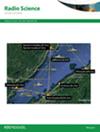An omnidirectional low-profile dual-polarized UWB antenna for dual-functional applications in Internet of vehicles
IF 1.5
4区 地球科学
Q3 ASTRONOMY & ASTROPHYSICS
引用次数: 0
Abstract
In this paper, a snowflake-shaped low-profile ultra-wideband (UWB) antenna is reported for dual function multiplexing of the Passive Keyless Entry and Start (PKES) system and the Automated Valet Parking (AVP) system. This antenna demonstrates preferred properties of omnidirectional radiation patterns and dual polarization. Both horizontally polarized (HP) and vertically polarized (VP) elements cover the UWB band, ensuing reliable signal receiving/transmitting. The omnidirectional radiation patterns are obtained over the whole working frequency band, which is much preferred in uses of PKES and AVP. To realize omnidirectional patterns, the HP antenna comprises eight dual-antipodal Vivaldi antennas arranged in a circular array, connected by a 1-to-8 power divider. Corrugated edges and shorting pins are introduced to improve bandwidth. Meanwhile, the VP antenna is formed by two cross low-profile tapered monopolies, which also provide omnidirectional radiation over the whole UWB range. The proposed antenna boasts a compact size of only 96 × 96 × 7 mm, with a height of 0.07λ面向车联网双功能应用的全向低轮廓双极化超宽带天线
本文报道了一种雪花形的低姿态超宽带(UWB)天线,用于无源无钥匙进入和启动(PKES)系统和自动代客泊车(AVP)系统的双功能复用。该天线具有全向辐射方向图和双极化特性。水平极化(HP)和垂直极化(VP)元件覆盖UWB频段,确保可靠的信号接收/发射。在整个工作频带内获得全向辐射方向图,这在PKES和AVP的使用中是非常理想的。为了实现全向模式,HP天线包括八个双对映维瓦尔第天线,排列成圆形阵列,由1比8功率分配器连接。引入波纹边和短引脚来提高带宽。同时,VP天线由两个交叉的低轮廓锥形垄断体组成,在整个UWB范围内提供全向辐射。该天线尺寸紧凑,仅为96 × 96 × 7 mm,高度为0.07λmin (λmin为最小工作频率下的自由空间波长)。实现的带宽范围为3.06-10.62 GHz,包括UWB频段和V2X频段。在不同方向上测量的增益变化小于3db,证实了满意的全向辐射。具体来说,在V2X频段,隔离度优于25 dB。这些有利的特性使该天线成为物联网中PKES和AVP超宽带应用的理想候选者。
本文章由计算机程序翻译,如有差异,请以英文原文为准。
求助全文
约1分钟内获得全文
求助全文
来源期刊

Radio Science
工程技术-地球化学与地球物理
CiteScore
3.30
自引率
12.50%
发文量
112
审稿时长
1 months
期刊介绍:
Radio Science (RDS) publishes original scientific contributions on radio-frequency electromagnetic-propagation and its applications. Contributions covering measurement, modelling, prediction and forecasting techniques pertinent to fields and waves - including antennas, signals and systems, the terrestrial and space environment and radio propagation problems in radio astronomy - are welcome. Contributions may address propagation through, interaction with, and remote sensing of structures, geophysical media, plasmas, and materials, as well as the application of radio frequency electromagnetic techniques to remote sensing of the Earth and other bodies in the solar system.
 求助内容:
求助内容: 应助结果提醒方式:
应助结果提醒方式:


